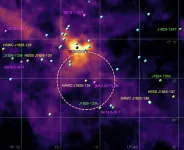(Press-News.org) Shipping provides the very foundation for world trade, by moving an estimated 11 billion tonnes of goods a year from where they are produced to where they will be used. From TVs to toasters, soap to sugar -- much of it moves over the waves.
Yet for ships plying the open ocean and for offshore industries, waves present an enormous challenge --because they can increase operational risks, reduce operating efficiency, and be dangerous if large enough and not handled well -- and they can be difficult to predict.
Ships can access information about wave heights, directions and frequency, but those data may be expensive to obtain or delayed because of satellite communication limitations, says Zhengru Ren, a postdoctoral fellow at the Norwegian University of Science and Technology's (NTNU) Department of Marine Technology and the research centre SFI MOVE.
Those challenges led Ren and his colleagues to take a different approach to estimating sea states, which is what mariners and researchers collectively call wave heights, frequencies and directions. The method is described in a new peer-reviewed article in Marine Structures.
Instead of relying on specialized meteorological instruments, the researchers used the movement of the ship itself to estimate wave conditions in real time.
"This method allows a real-time estimation without extra costs for measurement instruments. We believe that this technique is promising because it is general and works for almost all ships without extra cost," Ren said. "Another advantage is that it is very easy to apply in temporary scenarios."
The approach relies on cause and effect calculations, but not in the way you might think, says Roger Skjetne, a professor at NTNU's Department of Marine Technology who was senior author of the paper.
"In principle, the prediction algorithm is based on cause and effect, but in this case we measure the effect - the ship movements - and estimate the cause - the waves that affect the ship," Skjetne said. "If we do this for long enough, we're able to reconstruct the significant part of the wave spectrum."
One of the keys to understand what Ren and his colleagues did is to realize that a ship is asymmetric, meaning that it will rock or move differently based on the direction and the size of the waves it encounters.
Think of it like this: If a ship were perfectly round, like a ball, it would respond to waves pretty much the same way, except perhaps for direction.
But ships are shaped more like an ellipse with one flat end. That means the effect of the waves will be different, depending upon where the waves hit the ship. Another factor that affects the ship's movement will be the specific geometry of the ship's hull.
The researchers developed a mathematical approach to combine all of this information about the ship's geometry, dynamic motions, and wave influence, which can be calculated beforehand. They then combined this with mathematical formulas that are used to calculate information about waves from floating structures.
The researchers assumed that the ship was being kept in one location by a dynamic positioning system. A ship with a dynamic positioning system has several thrusters on its hull which work together to hold the ship at one location, based on GPS information.
But this wasn't quite enough to come up with the information that would be useful for mariners, Ren and his colleagues realized.
"This is an interesting and exciting research topic. But how to use extra information or ways to improve the estimates absorbed my thoughts," Ren said.
In the end, the researchers used two different mathematical techniques to fine-tune their calculations. One involved smoothing out the slopes of the waves a little differently, by using something called a Bézier surface.
The second involved optimizing the calculations for disturbances and errors that come from the vessel's responses to the waves.
But before the algorithm can be used in a shipboard computer to convert the ship motion sensor signals into the prevailing directional wave spectrum, in real-time, the ship has to have something called motion response amplitude operators (RAOs) available.
"These are mathematical transfer functions that are calculated beforehand, using ship design computer programs, in order to understand how certain waves result in movements (responses) of the ship," Skjetne said. "This makes it possible to invert the problem, by measuring the movements and then use the RAOs to say something about the incoming waves."
"We believe that this budget-friendly technique will be promising in future maritime industry," Ren said. "After improving the smoothness and robustness issues, the time spent on careful parameter tuning can be relaxed, making it easy to use on a given vessel. In turn, this ensures more efficient marine operations - which is what we aim for in the Centre for Research Based innovation on Marine Operations (SFI MOVE)."
INFORMATION:
Reference:
Zhengru Ren, Xu Han, Amrit Shankar Verma, Johann Alexander Dirdal, Roger Skjetne. (2021) Sea state estimation based on vessel motion responses: Improved smoothness and robustness using Bézier surface and L1 optimization. Marine Structures,Vol. 76, https://doi.org/10.1016/j.marstruc.2020.102904.
Undocumented women in Finland access pregnancy care later than others. Yet, screening of infectious diseases at the early stages of pregnancy would be particularly important to these women, a new study carried out in Helsinki, Finland, shows. Conducted by the University of Eastern Finland and the University of Helsinki, the study on undocumented women's pregnancy care and childbirth was published in BMC Pregnancy and Childbirth.
Undocumented pregnant women constitute a vulnerable group of people who lack equal access to pregnancy care. Previous ...
Study finds that children who experienced housing loss in the 2011 Great East Japan Earthquake are more inclined to opt for short-term gratification
Tokyo - Living through a tragic event might make us more inclined to live for the moment, but not always in a good way. Research is looking into the psychological after-effects among children who survived the 2011 Great East Japan Earthquake, and a recent study may have made a connection: the children may forgo greater long-term reward for short-term pleasure.
Among the traumatic experiences in the quake and subsequent tsunami that killed almost 16,000 people, some survivors witnessed people washed ...
In their pursuit of maximum reward, people suffering from gambling disorder rely less on exploring new but potentially better strategies, and more on proven courses of action that have already led to success in the past. The neurotransmitter dopamine in the brain may play an important role in this, a study in biological psychology conducted at the University of Cologne's Faculty of Human Sciences by Professor Dr Jan Peters und Dr Antonius Wiehler suspects. The article 'Attenuated directed exploration during reinforcement learning in gambling disorder' has appeared in the latest edition of the Journal of Neuroscience, published ...
In cancer immunotherapy, cells in the patient's own immune system are activated to attack cancer cells. CAR T cell therapy has been one of the most significant recent advances in immunotherapies targeted at cancer.
In CAR T cell therapy, T cells are extracted from the patient for genetic modification: a chimeric antigen receptor (CAR) is transported into the cells using a viral vector, helping the T cells better identify and kill cancer cells. When the antigen receptor cells identify the desired surface structure in the patient's cells, they start multiplying and killing the target cells.
CAR T cell therapy was introduced to Finland in 2018, and the treatment form has been used in support of patients suffering from leukaemia and lymphomas.
So ...
A Delphi survey carried out by Dr Lyn Robinson, Head of Department and Reader in Library and Information Science at City, University of London, and Dr David Haynes, former Visiting Lecturer and Post-Doctoral Fellow in City's Department of Library and Information Science, has revealed priorities for protecting personal privacy online.
Their research study, "Delphi study of risk to individuals who disclose personal information online", published in the Journal of Information Science, was conducted at City in 2019, and is based on the views of a panel of privacy and information security experts.
A literature review, published between 2014 and ...
For years, in the vastness of our galaxy, astrophysicists have been tracking down pevatrons - natural accelerators of particles with monstrous energies. Thanks to the HAWC Observatory for Cosmic Radiation, another probable trace of their existence has just been found: photons with some of the highest energies. However, what is particularly important is that this time the high-energy photons have not only been recorded, but also their probable place of origin has been determined.
We know they exist, we just don't know where exactly they are or what they look like. Pevatrons - because this is what we are talking ...
Marine heatwaves are dramatically affecting the marine ecosystems of the world and the Mediterranean is no exception. In the Mediterranean, these extreme climate episodes and its resulting massive mortality of species are getting more and more intense and frequent. To date, most of the studies analysed the effects of these perturbations on specific species and populations, although researchers still do not know how this affects the functioning of the involved ecosystems.
A new study led by the University of Barcelona (UB) and the Institute of Marine Sciences (ICM-CSIC) has stated that marine heatwaves are having a strong impact on the functioning of coraligen, one of the most emblematic ...
A new study comparing decades of environmental monitoring records has confirmed that Canada's caribou are not faring as well as other animals like moose and wolves in the same areas--and also teased out why.
The study used 16 years of data to examine changes in vegetation, moose, wolves and caribou.
"Caribou are declining across Canada and have been recently lost in the Lower 48 States," says Melanie Dickie, a doctoral student with UBC Okanagan's Irving K. Barber Faculty of Science.
"Understanding why caribou are declining is the first step to effectively managing the species--it tells ...
Native reptile populations on Christmas Island have been in severe decline with two species, Lister's gecko and the blue-tailed skink, entirely disappearing from the wild. While previously the main driver for this decline is likely predation by invasive species and habitat destruction, a silent killer is now threatening to wipe the species out entirely.
Those bred in captivity on the Australian Territory in the Indian Ocean have also been mysteriously dying, leaving the two species - which number only around 1000 each - in danger of extinction. Veterinary scientists from the University of Sydney, the Australian Registry of Wildlife ...
A radio telescope located in outback Western Australia has observed a cosmic phenomenon with a striking resemblance to a jellyfish.
Published today in The Astrophysical Journal, an Australian-Italian team used the Murchison Widefield Array (MWA) telescope to observe a cluster of galaxies known as Abell 2877.
Lead author and PhD candidate Torrance Hodgson, from the Curtin University node of the International Centre for Radio Astronomy Research (ICRAR) in Perth, said the team observed the cluster for 12 hours at five radio frequencies between 87.5 and 215.5 megahertz.
"We looked at the data, and as we turned down the frequency, we saw a ghostly jellyfish-like ...




